Business Management Report: UPS India Market Analysis and Strategies
VerifiedAdded on 2020/05/11
|7
|1095
|86
Report
AI Summary
This report provides an analysis of United Parcel Service (UPS) operations in India. It begins with an executive summary outlining UPS's global presence and its entry into the Indian market. The report uses the Five Forces Model to assess the challenges and opportunities faced by UPS in India, including competition from DHL and FedEx, the risk of new entrants, the bargaining power of consumers and suppliers, and competitive rivalry within the market. The analysis considers factors like consumer decision-making processes and the importance of supplier relationships. The report suggests strategic recommendations such as product differentiation, cost effectiveness, and strengthening linkages with other enterprises to maintain UPS's market share in India. Finally, the report concludes by emphasizing the importance of adapting to the changing market dynamics and staying ahead of the competition.
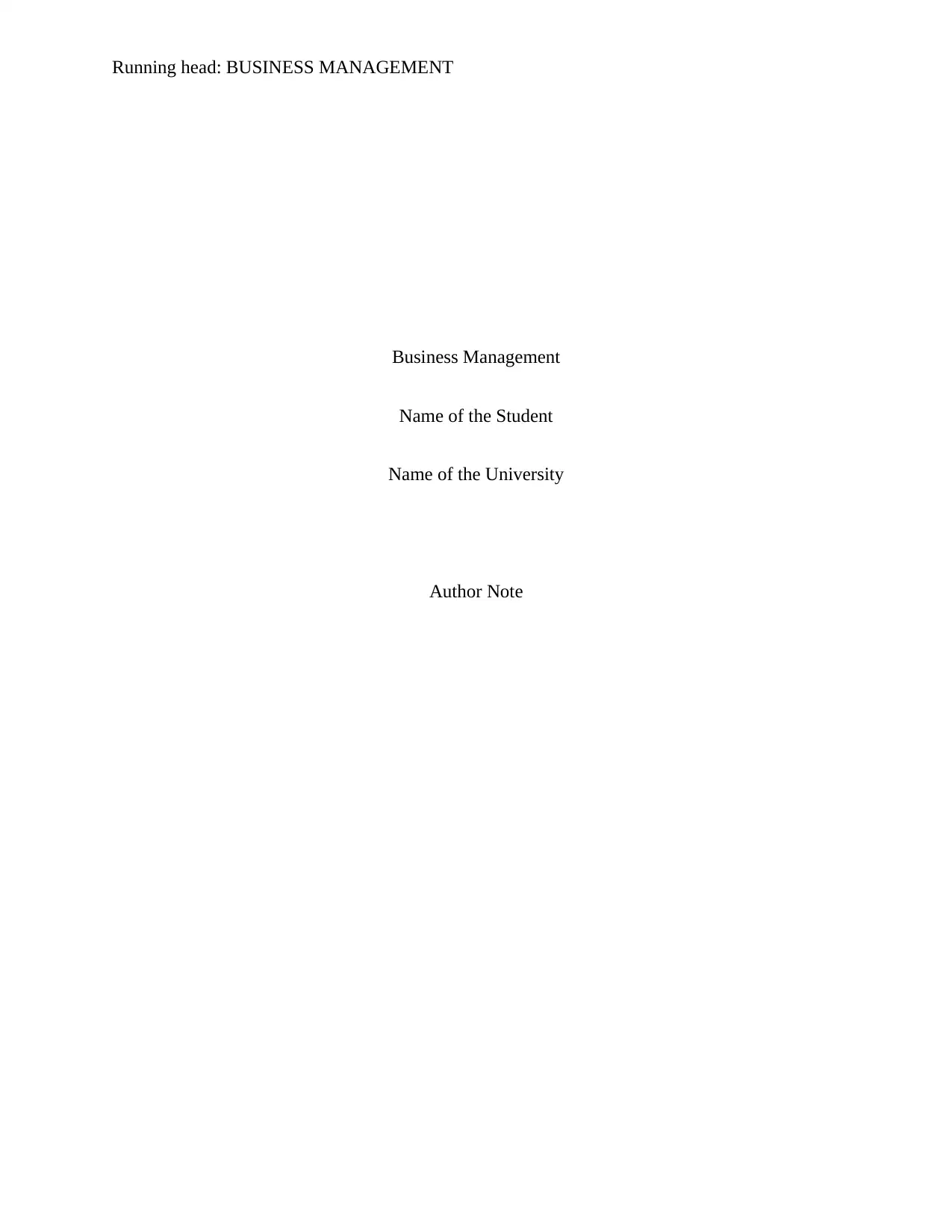
Running head: BUSINESS MANAGEMENT
Business Management
Name of the Student
Name of the University
Author Note
Business Management
Name of the Student
Name of the University
Author Note
Paraphrase This Document
Need a fresh take? Get an instant paraphrase of this document with our AI Paraphraser
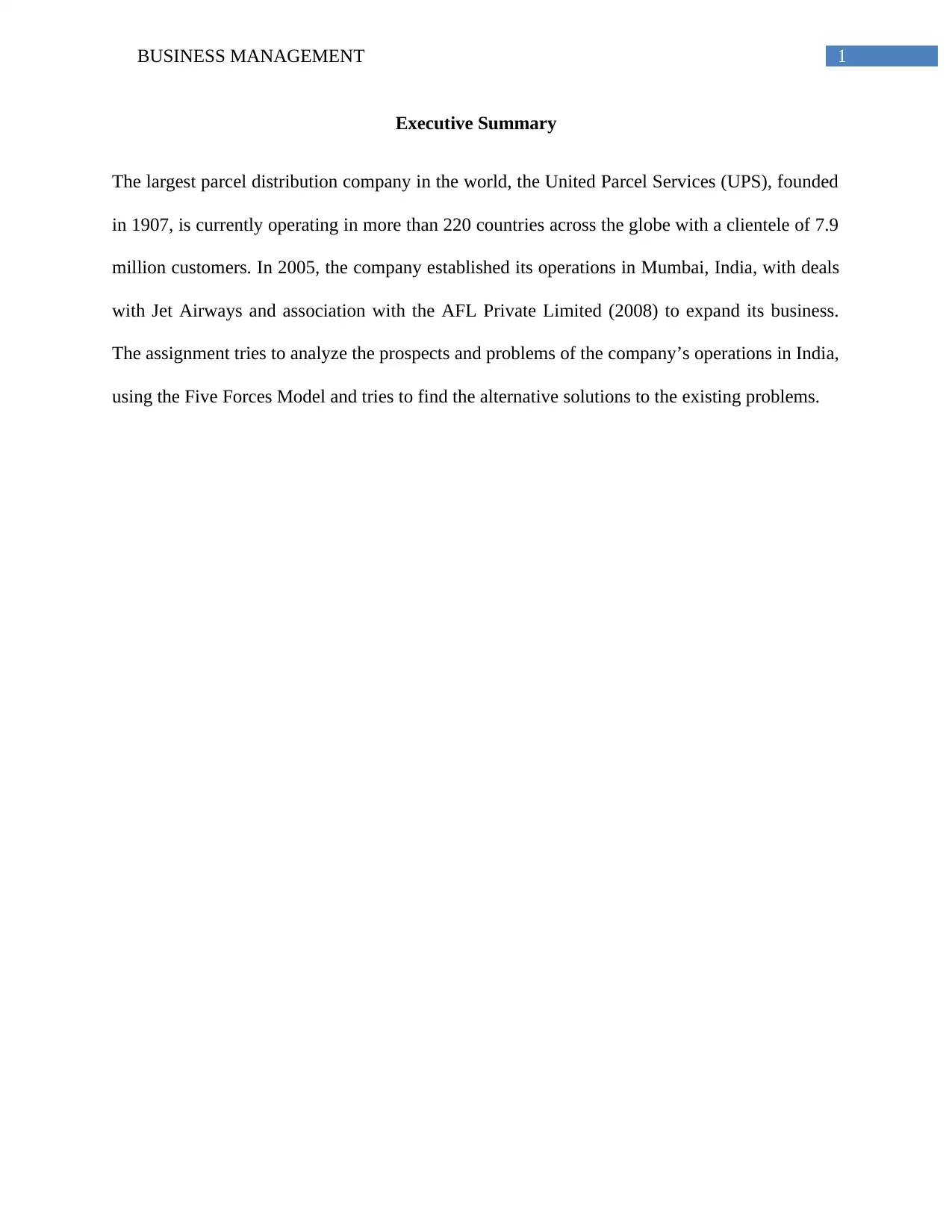
1BUSINESS MANAGEMENT
Executive Summary
The largest parcel distribution company in the world, the United Parcel Services (UPS), founded
in 1907, is currently operating in more than 220 countries across the globe with a clientele of 7.9
million customers. In 2005, the company established its operations in Mumbai, India, with deals
with Jet Airways and association with the AFL Private Limited (2008) to expand its business.
The assignment tries to analyze the prospects and problems of the company’s operations in India,
using the Five Forces Model and tries to find the alternative solutions to the existing problems.
Executive Summary
The largest parcel distribution company in the world, the United Parcel Services (UPS), founded
in 1907, is currently operating in more than 220 countries across the globe with a clientele of 7.9
million customers. In 2005, the company established its operations in Mumbai, India, with deals
with Jet Airways and association with the AFL Private Limited (2008) to expand its business.
The assignment tries to analyze the prospects and problems of the company’s operations in India,
using the Five Forces Model and tries to find the alternative solutions to the existing problems.
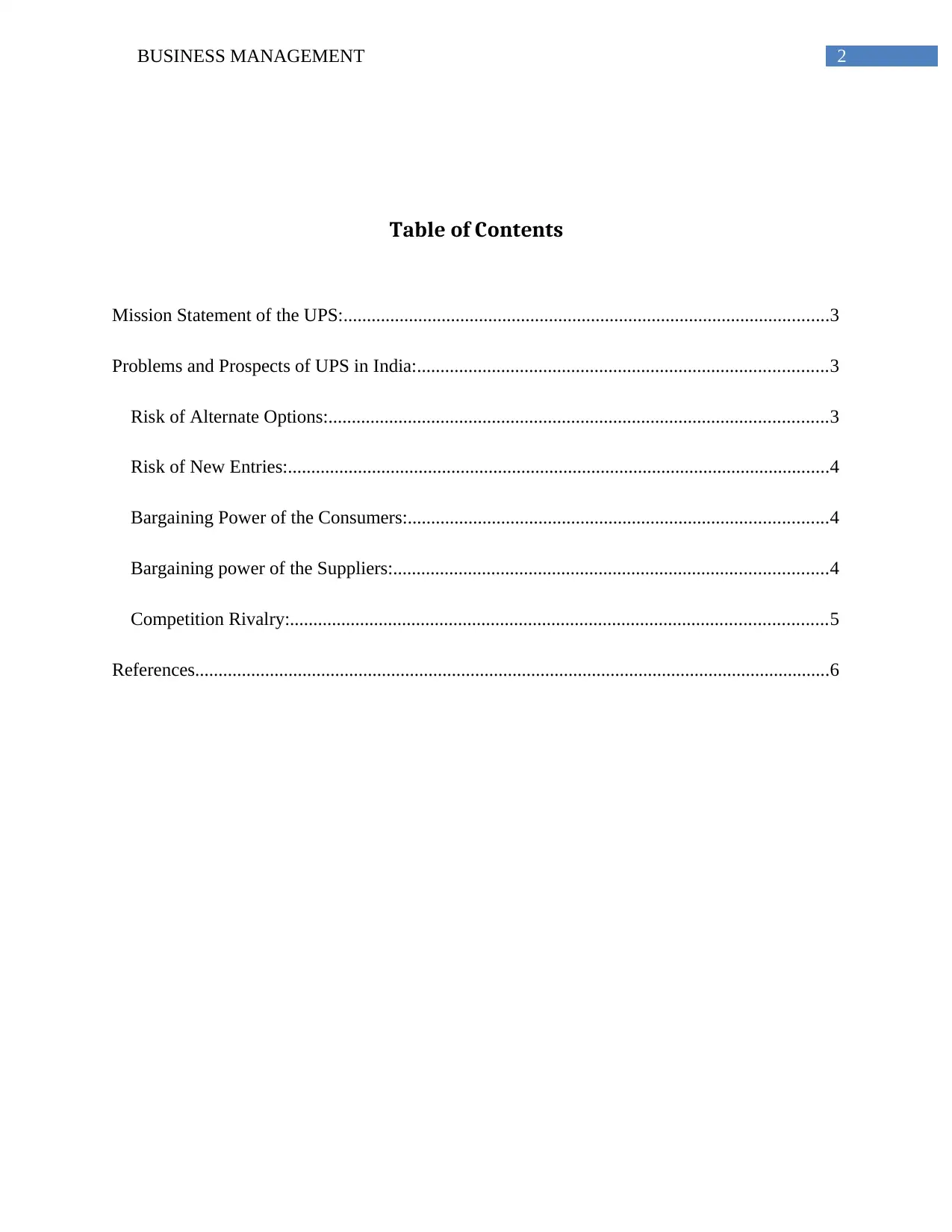
2BUSINESS MANAGEMENT
Table of Contents
Mission Statement of the UPS:........................................................................................................3
Problems and Prospects of UPS in India:........................................................................................3
Risk of Alternate Options:...........................................................................................................3
Risk of New Entries:....................................................................................................................4
Bargaining Power of the Consumers:..........................................................................................4
Bargaining power of the Suppliers:.............................................................................................4
Competition Rivalry:...................................................................................................................5
References........................................................................................................................................6
Table of Contents
Mission Statement of the UPS:........................................................................................................3
Problems and Prospects of UPS in India:........................................................................................3
Risk of Alternate Options:...........................................................................................................3
Risk of New Entries:....................................................................................................................4
Bargaining Power of the Consumers:..........................................................................................4
Bargaining power of the Suppliers:.............................................................................................4
Competition Rivalry:...................................................................................................................5
References........................................................................................................................................6
⊘ This is a preview!⊘
Do you want full access?
Subscribe today to unlock all pages.

Trusted by 1+ million students worldwide
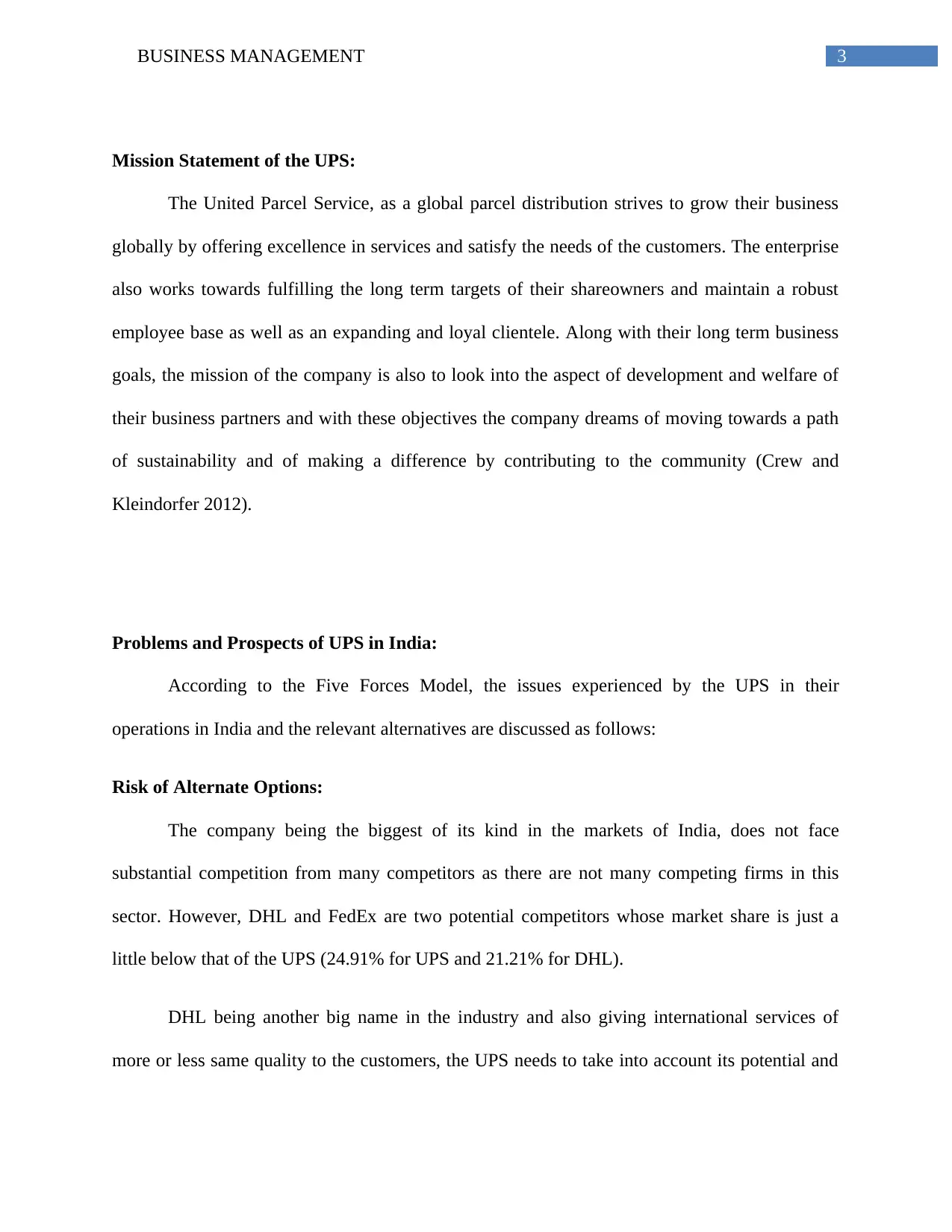
3BUSINESS MANAGEMENT
Mission Statement of the UPS:
The United Parcel Service, as a global parcel distribution strives to grow their business
globally by offering excellence in services and satisfy the needs of the customers. The enterprise
also works towards fulfilling the long term targets of their shareowners and maintain a robust
employee base as well as an expanding and loyal clientele. Along with their long term business
goals, the mission of the company is also to look into the aspect of development and welfare of
their business partners and with these objectives the company dreams of moving towards a path
of sustainability and of making a difference by contributing to the community (Crew and
Kleindorfer 2012).
Problems and Prospects of UPS in India:
According to the Five Forces Model, the issues experienced by the UPS in their
operations in India and the relevant alternatives are discussed as follows:
Risk of Alternate Options:
The company being the biggest of its kind in the markets of India, does not face
substantial competition from many competitors as there are not many competing firms in this
sector. However, DHL and FedEx are two potential competitors whose market share is just a
little below that of the UPS (24.91% for UPS and 21.21% for DHL).
DHL being another big name in the industry and also giving international services of
more or less same quality to the customers, the UPS needs to take into account its potential and
Mission Statement of the UPS:
The United Parcel Service, as a global parcel distribution strives to grow their business
globally by offering excellence in services and satisfy the needs of the customers. The enterprise
also works towards fulfilling the long term targets of their shareowners and maintain a robust
employee base as well as an expanding and loyal clientele. Along with their long term business
goals, the mission of the company is also to look into the aspect of development and welfare of
their business partners and with these objectives the company dreams of moving towards a path
of sustainability and of making a difference by contributing to the community (Crew and
Kleindorfer 2012).
Problems and Prospects of UPS in India:
According to the Five Forces Model, the issues experienced by the UPS in their
operations in India and the relevant alternatives are discussed as follows:
Risk of Alternate Options:
The company being the biggest of its kind in the markets of India, does not face
substantial competition from many competitors as there are not many competing firms in this
sector. However, DHL and FedEx are two potential competitors whose market share is just a
little below that of the UPS (24.91% for UPS and 21.21% for DHL).
DHL being another big name in the industry and also giving international services of
more or less same quality to the customers, the UPS needs to take into account its potential and
Paraphrase This Document
Need a fresh take? Get an instant paraphrase of this document with our AI Paraphraser
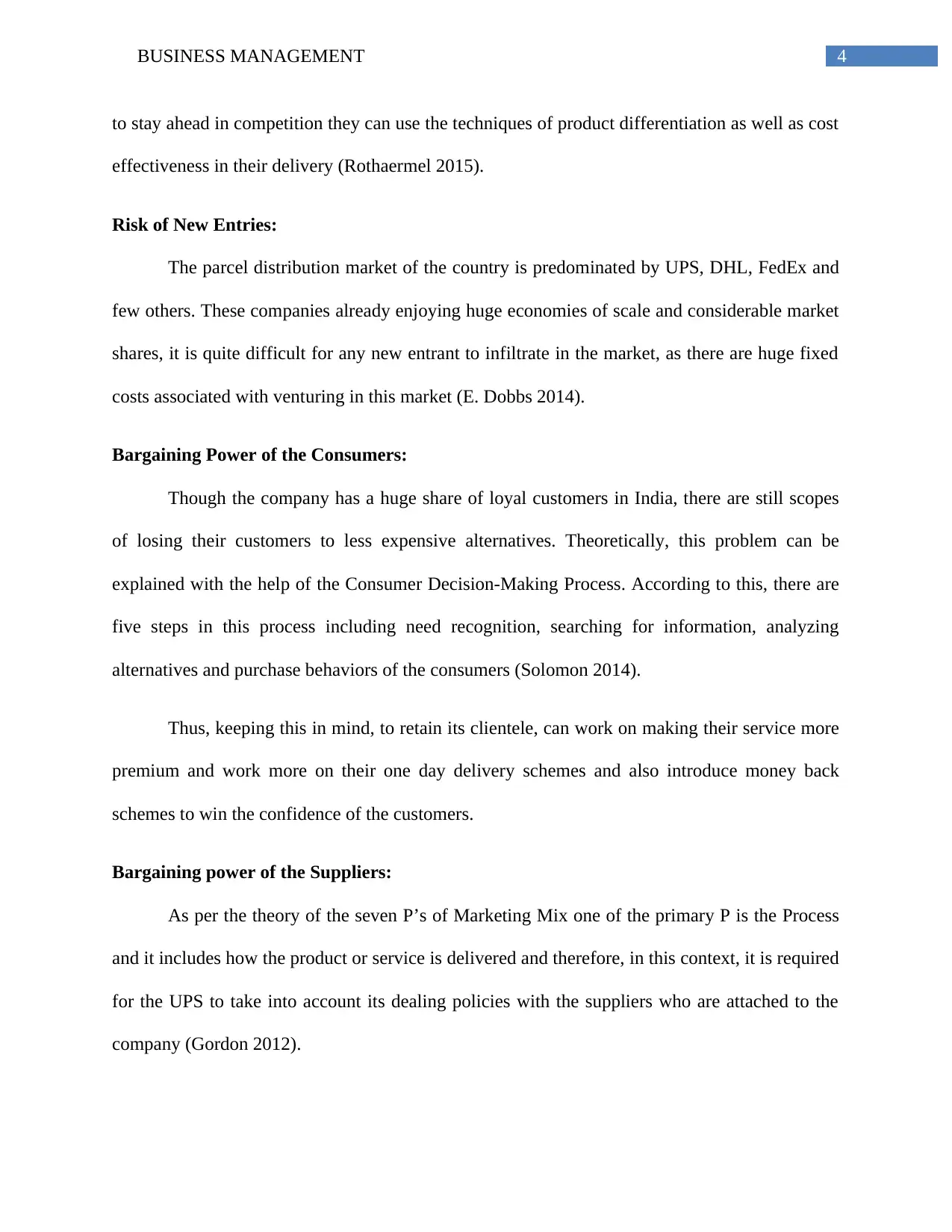
4BUSINESS MANAGEMENT
to stay ahead in competition they can use the techniques of product differentiation as well as cost
effectiveness in their delivery (Rothaermel 2015).
Risk of New Entries:
The parcel distribution market of the country is predominated by UPS, DHL, FedEx and
few others. These companies already enjoying huge economies of scale and considerable market
shares, it is quite difficult for any new entrant to infiltrate in the market, as there are huge fixed
costs associated with venturing in this market (E. Dobbs 2014).
Bargaining Power of the Consumers:
Though the company has a huge share of loyal customers in India, there are still scopes
of losing their customers to less expensive alternatives. Theoretically, this problem can be
explained with the help of the Consumer Decision-Making Process. According to this, there are
five steps in this process including need recognition, searching for information, analyzing
alternatives and purchase behaviors of the consumers (Solomon 2014).
Thus, keeping this in mind, to retain its clientele, can work on making their service more
premium and work more on their one day delivery schemes and also introduce money back
schemes to win the confidence of the customers.
Bargaining power of the Suppliers:
As per the theory of the seven P’s of Marketing Mix one of the primary P is the Process
and it includes how the product or service is delivered and therefore, in this context, it is required
for the UPS to take into account its dealing policies with the suppliers who are attached to the
company (Gordon 2012).
to stay ahead in competition they can use the techniques of product differentiation as well as cost
effectiveness in their delivery (Rothaermel 2015).
Risk of New Entries:
The parcel distribution market of the country is predominated by UPS, DHL, FedEx and
few others. These companies already enjoying huge economies of scale and considerable market
shares, it is quite difficult for any new entrant to infiltrate in the market, as there are huge fixed
costs associated with venturing in this market (E. Dobbs 2014).
Bargaining Power of the Consumers:
Though the company has a huge share of loyal customers in India, there are still scopes
of losing their customers to less expensive alternatives. Theoretically, this problem can be
explained with the help of the Consumer Decision-Making Process. According to this, there are
five steps in this process including need recognition, searching for information, analyzing
alternatives and purchase behaviors of the consumers (Solomon 2014).
Thus, keeping this in mind, to retain its clientele, can work on making their service more
premium and work more on their one day delivery schemes and also introduce money back
schemes to win the confidence of the customers.
Bargaining power of the Suppliers:
As per the theory of the seven P’s of Marketing Mix one of the primary P is the Process
and it includes how the product or service is delivered and therefore, in this context, it is required
for the UPS to take into account its dealing policies with the suppliers who are attached to the
company (Gordon 2012).
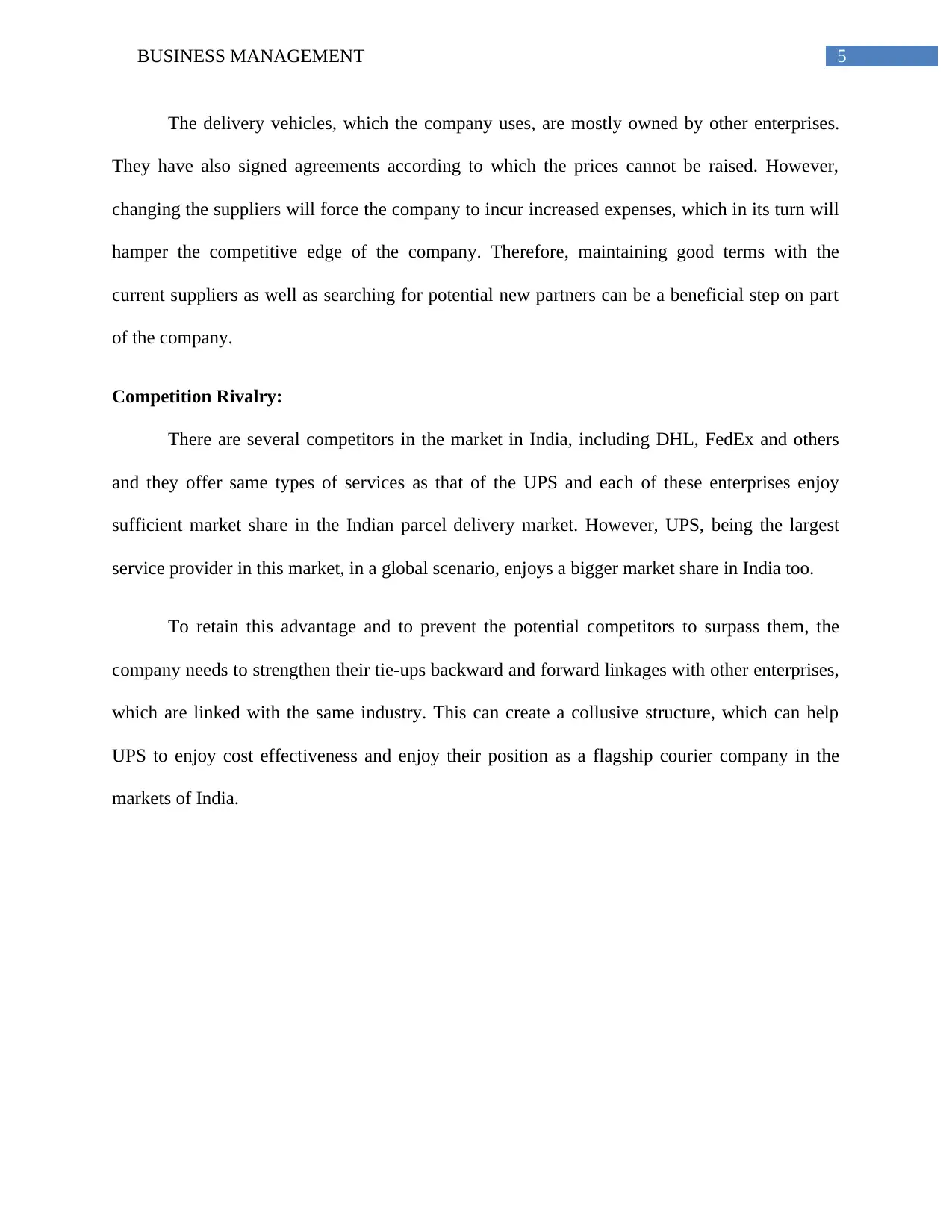
5BUSINESS MANAGEMENT
The delivery vehicles, which the company uses, are mostly owned by other enterprises.
They have also signed agreements according to which the prices cannot be raised. However,
changing the suppliers will force the company to incur increased expenses, which in its turn will
hamper the competitive edge of the company. Therefore, maintaining good terms with the
current suppliers as well as searching for potential new partners can be a beneficial step on part
of the company.
Competition Rivalry:
There are several competitors in the market in India, including DHL, FedEx and others
and they offer same types of services as that of the UPS and each of these enterprises enjoy
sufficient market share in the Indian parcel delivery market. However, UPS, being the largest
service provider in this market, in a global scenario, enjoys a bigger market share in India too.
To retain this advantage and to prevent the potential competitors to surpass them, the
company needs to strengthen their tie-ups backward and forward linkages with other enterprises,
which are linked with the same industry. This can create a collusive structure, which can help
UPS to enjoy cost effectiveness and enjoy their position as a flagship courier company in the
markets of India.
The delivery vehicles, which the company uses, are mostly owned by other enterprises.
They have also signed agreements according to which the prices cannot be raised. However,
changing the suppliers will force the company to incur increased expenses, which in its turn will
hamper the competitive edge of the company. Therefore, maintaining good terms with the
current suppliers as well as searching for potential new partners can be a beneficial step on part
of the company.
Competition Rivalry:
There are several competitors in the market in India, including DHL, FedEx and others
and they offer same types of services as that of the UPS and each of these enterprises enjoy
sufficient market share in the Indian parcel delivery market. However, UPS, being the largest
service provider in this market, in a global scenario, enjoys a bigger market share in India too.
To retain this advantage and to prevent the potential competitors to surpass them, the
company needs to strengthen their tie-ups backward and forward linkages with other enterprises,
which are linked with the same industry. This can create a collusive structure, which can help
UPS to enjoy cost effectiveness and enjoy their position as a flagship courier company in the
markets of India.
⊘ This is a preview!⊘
Do you want full access?
Subscribe today to unlock all pages.

Trusted by 1+ million students worldwide
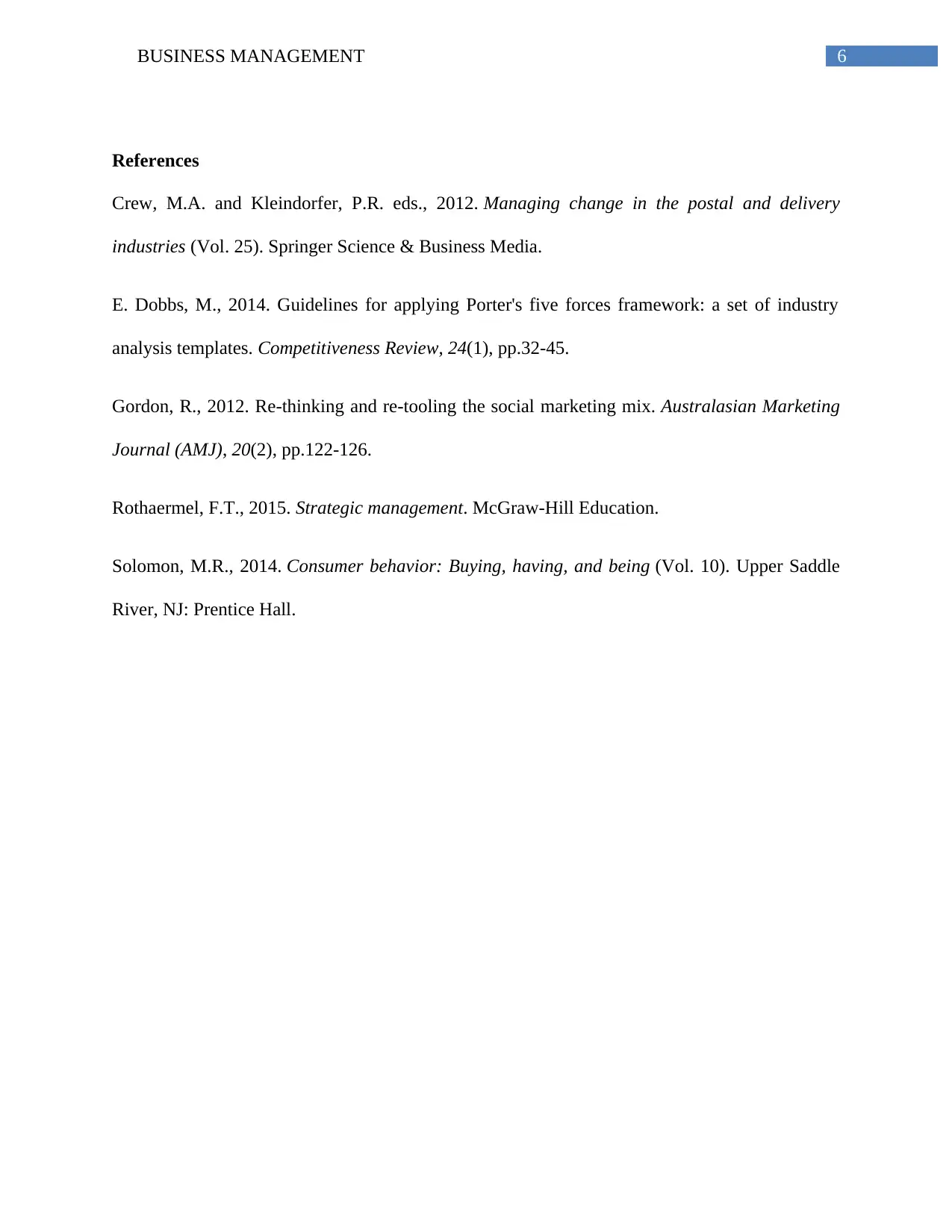
6BUSINESS MANAGEMENT
References
Crew, M.A. and Kleindorfer, P.R. eds., 2012. Managing change in the postal and delivery
industries (Vol. 25). Springer Science & Business Media.
E. Dobbs, M., 2014. Guidelines for applying Porter's five forces framework: a set of industry
analysis templates. Competitiveness Review, 24(1), pp.32-45.
Gordon, R., 2012. Re-thinking and re-tooling the social marketing mix. Australasian Marketing
Journal (AMJ), 20(2), pp.122-126.
Rothaermel, F.T., 2015. Strategic management. McGraw-Hill Education.
Solomon, M.R., 2014. Consumer behavior: Buying, having, and being (Vol. 10). Upper Saddle
River, NJ: Prentice Hall.
References
Crew, M.A. and Kleindorfer, P.R. eds., 2012. Managing change in the postal and delivery
industries (Vol. 25). Springer Science & Business Media.
E. Dobbs, M., 2014. Guidelines for applying Porter's five forces framework: a set of industry
analysis templates. Competitiveness Review, 24(1), pp.32-45.
Gordon, R., 2012. Re-thinking and re-tooling the social marketing mix. Australasian Marketing
Journal (AMJ), 20(2), pp.122-126.
Rothaermel, F.T., 2015. Strategic management. McGraw-Hill Education.
Solomon, M.R., 2014. Consumer behavior: Buying, having, and being (Vol. 10). Upper Saddle
River, NJ: Prentice Hall.
1 out of 7
Related Documents
Your All-in-One AI-Powered Toolkit for Academic Success.
+13062052269
info@desklib.com
Available 24*7 on WhatsApp / Email
![[object Object]](/_next/static/media/star-bottom.7253800d.svg)
Unlock your academic potential
Copyright © 2020–2025 A2Z Services. All Rights Reserved. Developed and managed by ZUCOL.





